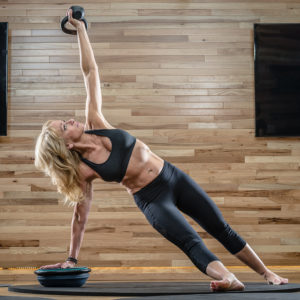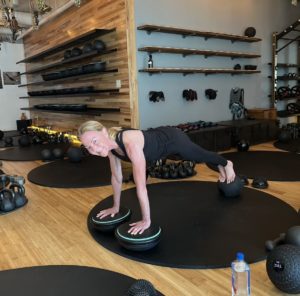The Aging Adult Balance-Strength™ Problem:
-
Falls are the #1 cause of injury & related death for adults over age 65.[i]
-
According to recent studies, individuals are twice as likely to die in the next decade if they are unable to hold a single leg balance for a minimum of 10 seconds.[ii]
-
Fall injuries = $80 Billion (& rising) in medical costs each year in the U.S.[iii] Projections show this to increase to over $101 Billion by 2030.[iv]
-
The average cost for treating a fall injury is $64,000.[v]
-
Balance loss begins in our 20’s, amplifies falls and injury probability, and lowers quality of life and longevity unless we counteract it.[vi] [vii]
-
 Falling once doubles the risk of falling again.[viii] 50% of aging adults and others who fear falling limit their social and physical activities due to this fear, further worsening their problem.[ix] However, studies show that regular strength and balance training can significantly reduce age-induced neuromuscular risk factors with a fall rate reduction of up to 50%.[x]
Falling once doubles the risk of falling again.[viii] 50% of aging adults and others who fear falling limit their social and physical activities due to this fear, further worsening their problem.[ix] However, studies show that regular strength and balance training can significantly reduce age-induced neuromuscular risk factors with a fall rate reduction of up to 50%.[x]
The Dynamic Balance-Strength Training System™ Solution:
-
For aging adults, Balance-Strength™ training is essential to improve balance, muscular strength, and flexibility, all of which contribute to overall health, independence, and enhancement in the quality of life and longevity.[xi] [xii]
-
Improves bone density and builds and maintains functional muscle strength.[xiii]
-
Reduces the risk of falls, which are the leading cause of injury and injury related deaths among older adults, with one study showing a reduction by as much as 39%.[xiv]
-
 A recent study advocates for training programs tailored to enhance reactive balance which can provide sensory neural feedback essential for balance.[xv]
A recent study advocates for training programs tailored to enhance reactive balance which can provide sensory neural feedback essential for balance.[xv] -
Enhances stability to maintain the ability to move freely and confidently, crucial for daily activities.[xvi]
-
Provides greater independence in performing tasks such as walking, climbing stairs, and carrying groceries – enhancing the ability to live independently.[xvii]
-
Improves cognitive function and reduces the risk of cognitive decline and dementia.[xviii] [xix]
The Best Way to Improve Balance-Strength™ for Aging Adults:
-
Challenge it by training with the ZeSa® Dynamic Balance-Strength Training System™. It is highly effective when done carefully and progressively.
-
The ZeSa Balance-Strength Analysis™ app provides an initial assessment to determine an aging adult’s balance capabilities, and a recent study shows this measure could be a screening tool for early mild cognitive impairment disorders.[xx] ZeSa’s app will also aid in identifying muscle imbalances, compromised joints, injuries, and strong-side/weak-side. This will also provide insight to determine the most appropriate ZeSa device level for training. The app allows you to periodically measure your Balance-Strength™ performance and track your progress.
-
The ZeSa Balance-Strength Training™ app provides pre-made training programs to follow for regular training sessions. It also allows creation of your own training programs which you can save in your account and follow whenever you desire, making setting up training sessions fun and easy.
-
Training single leg balance should be emphasized before introducing movement and weights, which will also help to build confidence and strength. Note that holding onto a stable surface or beginning on the ground may be necessary before safely progressing with assistance-free instability.
-
Incorporating dynamic movements such as step-ups and functional movements that mimic daily activities (reaching, turning, pivoting and bending) while training on ZeSa’s devices will improve functional balance, strength and flexibility.
-
Adding weights and gradually increasing challenging movements will continue to improve balance, while simultaneously improving bone density and muscular strength.
-
Increasing levels of difficulty with ZeSa’s progressive level devices will continue to compound the benefits noted above.
REFERENCES:
[i] Kakara R, Bergen G, Burns E, Stevens M. Nonfatal and Fatal Falls Among Adults Aged ≥65 Years -United States, 2020-2021. MMWR Morb Mortal Wkly Rep. 2023 Sep 1;72(35):938-943. doi: 10.15585/mmwr.mm7235a1. PMID: 37651272.
[ii] Araujo CG, de Souza e Silva CG, Laukkanen JA, et al. Successful 10-second one-legged stance performance predicts survival in middle-aged and older individuals. British Journal of Sports Medicine 2022;56:975-980.
[iii] Haddad YK, Miller GF, Kakara R, et al. Healthcare spending for non-fatal falls among older adults, USA Injury Prevention 2024;30:272-276.
[iv] Houry D, Florence C, Baldwin G, Stevens J, McClure R. The CDC Injury Center’s response to the growing public health problem of falls among older adults. Am J Lifestyle Med. 2016 Jan-Feb; Found on the internet at https://www.ncbi.nlm.nih.gov/pmc/articles/PMC4681302/
[v] https://www.archives-pmr.org/article/S0003-9993(14)00031-8/fulltext
[vi] Horak, F. B., & Shupert, C. L. (1994). Role of the vestibular system in postural control. Gait & Posture, 1(2), 99-108. DOI: 10.1016/0966-6362(94)90020-5.
[vii] Lord, S. R., & Menz, H. B. (2000). Visual contributions to postural stability in older adults. Journal of Gerontology: Series A, Biological Sciences and Medical Sciences, 55(8), M489-M494. DOI: 10.1093/gerona/55.8.M489.
[viii] https://www.cdc.gov/falls/data-research/facts-stats/index.html
[ix] Jefferis, B.J., Iliffe, S., Kendrick, D. et al. How are falls and fear of falling associated with objectively measured physical activity in a cohort of community-dwelling older men?. BMC Geriatr 14, 114 (2014). https://doi.org/10.1186/1471-2318-14-114
[x] Sherrington, C., Whitney, J. C., Lord, S. R., Herbert, R. D., Cumming, R. G., & Close, J. C. (2008). Effective exercise for the prevention of falls: A systematic review and meta-analysis. Journal of the American Geriatrics Society, 56(12), 2234-2243. DOI: 10.1111/j.1532-5415.2008.02014.x.
[xi] Sturnieks, D. L., St George, R., & Lord, S. R. (2008). Balance disorders in the elderly. Neurophysiologie Clinique/Clinical Neurophysiology, 38(6), 467-478. DOI: 10.1016/j.neucli.2008.09.001.
[xii] Fiatarone Singh, M. A., Singh, N. A., & Marcus, R. L. (2014). The role of exercise in the prevention of osteoporosis and falls. Journal of the American Geriatrics Society, 62(1), 74-83. DOI: 10.1111/jgs.12606.
[xiii] Wolff, I., van Croonenborg, J. J., Kemper, H. C., Kostense, P. J., & Twisk, J. W. (1999). The effect of exercise training programs on bone mass: a meta-analysis of published controlled trials in pre- and postmenopausal women. Osteoporosis International, 9(1), 1-12. DOI: 10.1007/s001980050103.
[xiv] Reduces the risk of falls, which are the leading cause of injury and injury related deaths among older adults.
[xv] Jones R, Ratnakumar N, Akbaş K, Zhou X. Delayed center of mass feedback in elderly humans leads to greater muscle co-contraction and altered balance strategy under perturbed balance: A predictive musculoskeletal simulation study. PLoS One. 2024 May 24;19(5):e0296548. doi: 10.1371/journal.pone.0296548. PMID: 38787871; PMCID: PMC11125460.
[xvi] Sturnieks, D. L., St George, R., & Lord, S. R. (2008). Balance disorders in the elderly. Neurophysiologie Clinique/Clinical Neurophysiology, 38(6), 467-478. DOI: 10.1016/j.neucli.2008.09.001.
[xvii] Nelson ME, Rejeski WJ, Blair SN, Duncan PW, Judge JO, King AC, Macera CA, Castaneda-Sceppa C. Physical activity and public health in older adults: recommendation from the American College of Sports Medicine and the American Heart Association. Med Sci Sports Exerc. 2007 Aug;39(8):1435-45. doi: 10.1249/mss.0b013e3180616aa2. PMID: 17762378.
[xviii] Rogge AK, Röder B, Zech A, Nagel V, Hollander K, Braumann KM, Hötting K. Balance training improves memory and spatial cognition in healthy adults. Sci Rep. 2017 Jul 18;7(1):5661. doi: 10.1038/s41598-017-06071-9. Erratum in: Sci Rep. 2018 Nov 22;8(1):17434. doi: 10.1038/s41598-018-35957-5. PMID: 28720898; PMCID: PMC5515881.
[xix] Rogge AK, Röder B, Zech A, Hötting K. Exercise-induced neuroplasticity: Balance training increases cortical thickness in visual and vestibular cortical regions. Neuroimage. 2018 Oct 1;179:471-479. doi: 10.1016/j.neuroimage.2018.06.065. Epub 2018 Jun 26. PMID: 29959048.
[xx] Suzuki, Y., Tsubaki, T., Nakaya, K. et al. New balance capability index as a screening tool for mild cognitive impairment. BMC Geriatr 23, 74 (2023). https://doi.org/10.1186/s12877-023-03777-6
